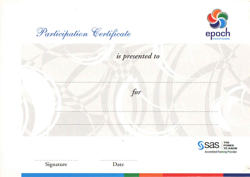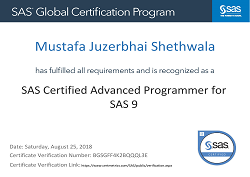- Home
- Advanced SAS Certification Course (Upto 30% Discount)
Advanced SAS Certification Course (Upto 30% Discount)
This course is for SAS programmers who prepare data for analysis. The comparisons of manipulation techniques and resource cost benefits are designed to help programmers choose the most appropriate technique for their data situation. Online Training ( Live Instructor Led Training Program) Classroom Training Upto 50% Discount
Power up your staff’s skills and boost your business
Course Description
It focuses on the components of the SAS macro facility and how to design, write, and debug macro systems. Emphasis is placed on understanding how programs with and without macro code are processed. It also covers how to process SAS data using Structured Query Language (SQL)
Discover High-Quality Courses On All The Topics You Care About. Start Your Course Today And Join Over Million People Learning Online at Epoch! Join epoch Today. Enrol now. Advance your Career. Easy Access/Simple Learning. Affordable fees.
About Program
This course is for SAS programmers who prepare data for analysis. The comparisons of manipulation techniques and resource cost benefits are designed to help programmers choose the most appropriate technique for their data situation. It focuses on the components of the SAS macro facility and how to design, write, and debug macro systems. Emphasis is placed on understanding how programs with and without macro code are processed. It also covers how to process SAS data using Structured Query Language (SQL).This course helps you prepare you for the following certification exam(s): SAS Certified Advanced Programmer for SAS 9.
Now with SAS Online Instructor Led Training one can easily get training started without having to travel. Plus with flexible batch timing & online lab access options it makes it easy for candidates to clip and usage their time in best possible fashion.
Format of Training
Live Web Classroom
Training is Led by an expert instructor live online using live web training platform, and this are not pre recorded lectures. Trainer can virtually look over your shoulder. Discuss, share, exchange ideas with students from different countries.
Taste of Live Web - is a perfect platform for indivudals who fear online training. SAS® gives an opportunity to all the registrants to have a closer look at different courses given below with a blend of Online Learning.
All the benefits of the classroom without the travel:
Classroom training options include courses offered in our regional training centers or via our Live Web classroom.
Taught by certified instructors at High-Tech facilities across the country:
- A SAS expert at your side.
- Focused learning away from the office
- Networking opportunities
- State-of-the-art facilities
- Electronic course notes downloadable to your device and permission to print
- Business Knowledge Series: in-depth courses on the latest business topics
- We offer Connected Classes! Watch for courses in Cary, New York, Arlington, Dallas and San Francisco that connect remote students via our Live Web classroom.
Prerequisite
Before attending this course, you should have experience using computer software. Specifically, you should be able to
- Read raw data files and SAS data sets
- Investigate and summarize data by generating frequency tables and descriptive statistics
- Create SAS variables and recode data values
- Subset data
- Combine multiple SAS files
- Create listing, summary, HTML, and graph reports.
**Practice Project & Case Study is Provided for enhancement of programming and conceptual fundamentals"
Training Features
- use macro code to write more efficient SAS programs
- use the SQL procedure as an easy, flexible way to query and combine your data
- use advanced SAS programming techniques such as creating samples and indexes, using lookup tables to match data, and modifying and tracking data set changes
- write SAS programs to maximize efficiency.
Course Curriculum
Introduction
- course logistics
- creating course data files
Efficient SAS Programming
- identifying computer resources related to efficiency
Controlling I/O Processing and Memory
- SAS DATA step processing
- controlling I/O
- reducing the length of numeric variables
- compressing SAS data sets
- using SAS views
Accessing Observations
- access methods
- accessing observations by number
- creating an index
- using an index
DATA Step Arrays
- introduction to lookup techniques
- one-dimensional arrays
- multidimensional arrays
- loading a multidimensional array from a SAS data set
DATA Step Hash and Hiter Objects
- hash object methods
- loading a hash object from a SAS data set
- DATA step hiter object
Combining Data Horizontally
- DATA step merges and SQL procedure joins
- using an index to combine data
- combining summary and detail data
- combining data conditionally
User-Defined Functions and Formats
- user-defined functions
- user-defined formats
Learning More
- areas of support from SAS
- other courses to consider
Introduction
- overview of SAS Foundation
- course logistics
- course data files
- introducing the Structured Query Language
Basic Queries
- overview of the SQL procedure
- specifying columns
- specifying rows
Displaying Query Results
- presenting data
- summarizing data
SQL Joins
- introduction to SQL joins
- inner joins
- outer joins
- complex SQL joins
Subqueries
- noncorrelated subqueries
- in-line views
Set Operators
- introduction to set operators
- the UNION operator
- the OUTER UNION operator
- the EXCEPT operator
- the INTERSECT operator
Creating Tables and Views
- creating tables with the SQL procedure
- creating views with the SQL procedure
Advanced PROC SQL Features
- dictionary tables and views
- using SQL procedure options
- interfacing PROC SQL with the macro language
Learning More
- SAS resources
- beyond this course
Introduction
- course logistics
- purpose of the macro facility
- program flow
Macro Variables
- introduction to macro variables
- automatic macro variables
- macro variable references
- user-defined macro variables
- delimiting macro variable references
- macro functions
Macro Definitions
- defining and calling a macro
- macro parameters
DATA Step and SQL Interfaces
- creating macro variables in the DATA step
- indirect references to macro variables
- creating macro variables in SQL
Macro Programs
- conditional processing
- parameter validation
- iterative processing
- global and local symbol tables
Learning More
- SAS resources
- beyond this course
Supplemental Materials
- program flow
This course focuses on the components of the SAS macro facility and how to design, write, and debug macro systems. Emphasis is placed on understanding how programs with macro code are processed.
Learn how to
- perform text substitution in SAS code
- automate and customize the production of SAS code
- conditionally or iteratively construct SAS code
- use macro variables and macro functions.
This course teaches you how to process SAS data using Structured Query Language (SQL).
Learn how to
- query and subset data
- summarize and present data
- combine tables, including complex joins and merges
- create and modify table views and indexes
- replace multiple DATA and PROC steps with one SQL query.
This course is for SAS programmers who prepare data for analysis. The comparisons of manipulation techniques and resource cost benefits are designed to help programmers choose the most appropriate technique for their data situation.
Learn how to compare various SAS programming techniques that enable you to
- benchmark computer resource usage
- control memory, I/O, and CPU resources
- create and use indexes
- combine data horizontally
- use hash and hiter DATA step component objects and arrays as lookup tables
- compress SAS data sets
- sample your SAS data sets
- create and use SAS data views
- safely reduce the length of numeric variables
- create user-defined functions and informats.
Project
- using SAS formats
- creating user-defined formats
- reading a SAS data set
- customizing a SAS data set
Certificate
FAQs
Each exam challenges candidates to apply specific knowledge they have acquired through SAS software training and/or job experience. Computer-based in format, SAS Global Certification exams comprise multiple-choice and/or short-answer questions, depending on the exam. Exams are generally scheduled through Pearson VUE but are also held at various locations around the world on a pre-scheduled basis. Candidates are allotted varying time limits to complete the exam, depending on which exam is taken. Specific exam content and passing criteria are located within each exam. To encourage your feedback, SAS Global Certification exams include a feature that allows candidates to comment on specific test questions. Your opinions are important to us and are a critical component in test development. Additionally, SAS Global Certification requires candidates to accept the terms of the SAS Institute Inc. Certification Program CandidatCancele Agreement before taking a certification exam.
Short-answer questions require you type your answer in a text box, rather than select your answer from four options. Typically, you will provide a numeric answer or a short section of SAS programming code. When entering code, case is ignored, and all variations of SAS syntax that correctly complete the program are accepted as correct.

 Course Description
Course Description About Program
About Program Format of Training
Format of Training Prerequisite
Prerequisite Training Features
Training Features Course Curriculum
Course Curriculum Project
Project Certificate
Certificate FAQs
FAQs Course Fees
Course Fees

 Watch
Watch Contact
Contact


 Find My Path
Find My Path